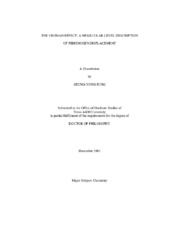| dc.description.abstract | Investigations of specific and nonspecific interactions of biomolecules at liquid/solid interfaces are presented. To investigate specific multivalent ligand-receptor interactions, bivalent antibodies and haptens bound to solid supported membrane were used as models for ligand-receptor coupling. Novel microfabrication strategies, which included spatially addressed bilayer arrays and heterogeneous microfluidic assays, in conjunction with total internal reflection microscopy, was employed to achieve this goal. These high throughput techniques allow thermodynamic data of binding interactions to be acquired with only a few microliters of analyte and superior signal to noise. The results yield both the first and second dissociation constant for bivalent IgG antibodies with membrane bound hapten molecules. Studies were conducted both as a function of hapten density and cholesterol content in the membrane.
Another research area of this dissertation is the molecular level description of nonspecific adsorption and displacement of the model protein, fibrinogen, onto hydrophilic surfaces. Techniques such as atomic force microscopy, immunochemical assays, fluorescence microscopy, and vibrational sum frequency spectroscopy were employed to probe this system. The results demonstrate that the protein's αC domains play the critical role. When fibrinogen is adsorbed to a hydrophilic surface via these moieties, its displacement rate in the presence of human plasma is approximately 170 times faster than when these domains are not in direct surface contact. Even more significantly, spectroscopic studies show evidence for highly aligned Arg and Lys residues interacting with the negatively charged substrate only when the αC domains make direct surface contact. The interfacial ordering of these residues appears to be the hallmark of a weak and labile electrostatic attraction between the substrate and the adsorbed macromolecule. | en |


